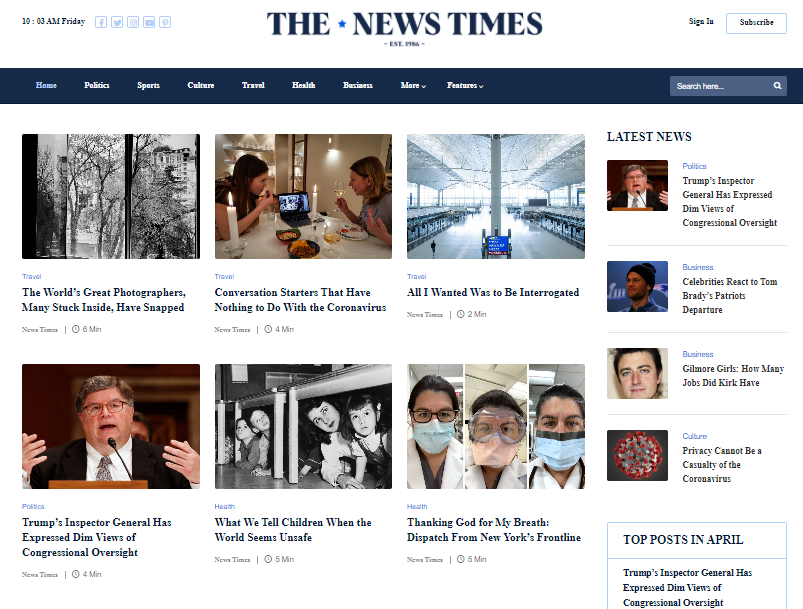What You Need to Know About stnews.live in 2025
The Impact of Social Network heading We Take In News Online
Social network has actually fundamentally changed news usage. It provides immediate accessibility to info, frequently eclipsing conventional media outlets. However, this rapid dissemination comes with challenges. Individuals encounter the risk of running into misinformation and coming to be trapped in echo chambers. The algorithms driving individualized material can obscure diverse perspectives. As these dynamics evolve, recognizing their ramifications ends up being essential for notified interaction in public discourse. What strategies might aid navigate this complicated landscape?
The Advancement of News Usage in the Digital Age
As technology progressed, the method people consumed news changed considerably in the electronic age (stnews.live). Conventional newspapers and transmitted media began to decline as the web arised as a key resource of details. Online systems used immediate access to newspaper article, video clips, and podcasts, allowing users to stay educated any time. The ease of smart phones additionally accelerated this shift, allowing individuals to get updates on the move
Additionally, the surge of news collectors and internet sites facilitated the consumption of diverse viewpoints, encouraging individuals to customize their news consumption based on individual interests. This development additionally prompted news companies to adjust their techniques, concentrating on digital web content and engaging readers with multimedia styles. Therefore, the traditional barriers of time and area in news distribution diminished, resulting in an extra prompt and customized news experience for target markets worldwide.
The Duty of Social Media Site Platforms in News Distribution
Social media site systems have transformed news distribution by offering instant access to information. Their algorithm-driven content curation commonly focuses on interaction over accuracy, leading to significant reliability difficulties (stnews.live). As individuals navigate this landscape, the ramifications for news consumption and public discussion become significantly complex
Instant News Gain Access To
Traditional news outlets have actually long been the key source of information, the increase of social media platforms has drastically changed how news is accessed and taken in. Instantaneous news access has come to be a hallmark of the electronic age, making it possible for individuals to receive updates in real time. Systems such as Twitter, Facebook, and Instagram enable news to spread out swiftly, commonly exceeding standard media in speed and reach. Users can share tales, discuss events, and involve with reporters, producing a vibrant communication between the target market and news content. This immediacy cultivates a culture of urgency, motivating users to look for info quickly. The assumption for prompt news has actually improved journalistic practices, engaging news companies to adapt their approaches to meet the needs of a hectic digital setting.
Algorithm-Driven Web content
While individuals actively involve with web content on social media sites, the formulas that control these platforms play a crucial function in figuring out which news stories obtain visibility. These algorithms evaluate individual actions, choices, and engagement metrics to curate personalized news feeds. As a result, particular stories might be intensified while others continue to be odd, commonly focusing on astonishing or trending subjects over substantive reporting. This discerning exposure forms individuals' understandings of current events and affects public discussion. In addition, the dependence on algorithm-driven web content can create resemble chambers, where users are mostly revealed to perspectives that line up with their own ideas. As a result, the dynamics of news circulation on social networks systems significantly impact how people consume and interpret info in the digital age.

Integrity Obstacles
As individuals increasingly turn to social media sites for news, the credibility of details experienced on these systems comes to be a pushing concern. The decentralized nature of social networks enables anyone to release material, usually blurring the lines in between trusted journalism and misinformation. Formulas focus on involvement over accuracy, leading to the prevalent circulation of mind-blowing or misleading tales. This environment postures considerable challenges for users trying to recognize credible resources. Social media systems, while endeavoring to battle false information with fact-checking and material moderation, run the gauntlet for inconsistencies and predispositions in their approaches. Eventually, the duty lies with individuals to seriously evaluate the news they eat, as the quick spread of information often outpaces confirmation efforts by systems.
The Increase of Citizen Journalism and User-Generated Web Content
The rise of person journalism has actually empowered everyday individuals to share news and viewpoints, typically providing understandings that standard media might overlook. This change also presents considerable obstacles, especially the spread of misinformation that can emerge from unverified material. As user-generated content comes to be a lot more common, the equilibrium between genuine voices and precision in coverage stays an essential problem.
Encouraging Everyday Voices

Obstacles of Misinformation
While the surge of citizen journalism has actually opened opportunities for diverse voices in the media landscape, it has likewise presented considerable challenges associated to false information. The convenience of sharing information through social media sites systems allows individuals to disseminate news rapidly, yet this quick spread commonly comes with the cost of accuracy. User-generated material often lacks the rigorous fact-checking and editorial oversight that standard journalism supplies. Sensationalized or false narratives can acquire traction, misguiding audiences and shaping public understanding. Moreover, the mixing of opinion and truth within social networks complicates the distinction between qualified details and false information. As a result, consumers need to browse a progressively complicated media environment, requiring critical assuming abilities to determine trustworthy news resources amidst the sound

False information and Its Ramifications for Public Discussion
As social networks platforms progressively dominate the landscape of info circulation, the spreading of false information presents substantial challenges for public discourse. Misinformation, often created to deceive or prompt emotional responses, can misshape perceptions of fact and threaten count on in credible resources. This phenomenon causes polarized viewpoints, as people are attracted in the direction of resemble chambers that reinforce their beliefs, additionally entrenching divisions within culture.
The ramifications for public discussion are profound. When citizens count on incorrect information, significant discussion lessens, and the democratic procedure suffers. Additionally, false information can incite worry and complication, influencing public health, security, and political stability. Because of this, promoting media literacy ends up being essential, empowering individuals to seriously examine info and determine fact from fiction. Addressing the challenges positioned by misinformation is crucial for maintaining the honesty of public discussion and guaranteeing a well-informed people with the ability of participating in constructive conversations.
The Influence of Algorithms on News Presence
Given the main function of algorithms in determining material presence, their impact on news usage is profound. These algorithms, made use of by social media sites systems, focus on particular sorts of web content based upon customer interaction and preferences. Consequently, news articles that align with preferred fads or target market interests are extra most likely to be displayed plainly, while much less sensational tales may be forgotten. This develops a setting where users are subjected mostly to details that strengthens their viewpoints, potentially bring about echo chambers.
The constant development of algorithms indicates that news companies must adjust their approaches to straighten with these transforming criteria, usually focusing on clickbait or emotionally charged headings. The integrity of news reporting can be endangered, as critical stories might not obtain the visibility they should have. The mathematical shaping of news visibility for that reason plays a necessary duty in affecting public perception and understanding of present occasions.
The Change Towards Visual Storytelling in News Media
Increasingly, news media is embracing visual storytelling as an effective device to involve target markets. This strategy leverages images, video clips, infographics, and interactive elements to convey information much go to my site more successfully than typical text-based layouts. As focus spans reduce, visuals supply a fast, impactful method to interact intricate tales and order visitors' passion.
Systems like Instagram and TikTok have more increased this fad, engaging news companies to adjust their material methods to fit these visually-driven atmospheres. By incorporating engaging visuals, news outlets can improve emotional connections and foster better understanding of topical concerns.
Aesthetic storytelling allows for more diverse stories, showcasing several viewpoints through vibrant discussions. As target markets progressively consume news via mobile tools, the shift towards visuals not only satisfies individual preferences yet likewise aids to break down obstacles to info access. Ultimately, this evolution reflects a broader improvement in exactly how news is produced and eaten in the digital age.
Future Trends: Browsing the Changing Landscape of News Usage
While the electronic landscape remains to develop, news intake is poised for substantial improvement driven by emerging innovations and changing audience actions. As man-made intelligence and maker understanding advancement, individualized news feeds will become a lot more widespread, enabling individuals to receive content customized to their interests. This modification could result in greater involvement however additionally raise issues concerning resemble chambers and misinformation.
The surge of voice-activated devices and smart speakers will influence just how news is supplied, changing the emphasis from aesthetic to acoustic formats. This pattern might urge news organizations to embrace even more succinct and engaging audio material.

Regularly Asked Questions
Just How Do Social Media Communications Affect News Reliability?
Social media site interactions can significantly affect perceptions of news credibility. Involvement metrics, such as likes and shares, frequently form audience depend on, with prominent messages obtaining viewed authenticity, no matter of the precision or dependability of the info presented.
What Role Do Influencers Play in Shaping News Narratives?
Influencers greatly form news narratives by leveraging their systems to amplify specific stories, usually tailoring web content to their audience. This can cause biased point of views, influencing public understanding and prioritizing sensationalism over accurate reporting.
Exactly How Can Users Identify Reliable News Resources on Social Network?
Customers can identify trusted news sources on social networks by examining the source's integrity, verifying truths via multiple electrical outlets, evaluating the professionalism of the material, and identifying prospective predispositions in reporting to assure accurate info.
What Effect Does Social Network Carry Conventional Journalism Jobs?
Social network substantially affects conventional journalism jobs by altering income designs, minimizing demand for print media, and cultivating competition from resident reporters. Consequently, many professionals encounter job insecurity and should adapt to quickly altering media landscapes.
Exactly How Do Various Demographics Consume News on Social Media?
Various demographics exhibit different choices for news usage on social media. Younger target markets prefer platforms like TikTok and Instagram for quick updates, while older people often tend to published here choose Twitter and facebook for extra comprehensive conversations and posts.